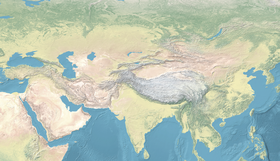
Back Sitio de Samarcanda Spanish محاصره سمرقند (۱۲۲۰) Persian Pengepungan Samarkand (1220) ID சமர்கந்து முற்றுகை (1220) Tamil Samarqand mudofaasi Uzbek 撒马尔罕之战 Chinese
| Battle of Samarkand (1220) | |||||||
|---|---|---|---|---|---|---|---|
 Equestrian battle in front of a city gate. Rashid ad-Din, Jami al-Tawarikh, 1300-1325 | |||||||
| |||||||
| Belligerents | |||||||
| Mongol Empire | Khwarazmian Empire | ||||||
| Commanders and leaders | |||||||
| Jalal-ad-Din Khwarazmshah | |||||||
| Units involved | |||||||
| City garrison | ||||||
| Strength | |||||||
| Unknown | Unknown | ||||||
| Casualties and losses | |||||||
| Unknown | All | ||||||
Location of the siege on a map of modern Uzbekistan | |||||||
The siege of Samarkand (1220) took place in 1220 A.D. after Genghis Khan, founder of the Mongol Empire, had launched a multi-pronged invasion of the Khwarazmian Empire, ruled by Shah Muhammad II. The Mongols had laid siege to the border town of Otrar, but finding its defences obdurate, a large force commanded by Genghis and his youngest son Tolui detached from the vanguard and set off southwards, towards Transoxiana.
Samarkand was the Shah's capital and the pivot of his defence — the city's garrison was large and its battlements were one of the strongest in the empire. Genghis, however, managed to isolate it by capturing and destroying Bukhara in a surprise manoeuvre, and then laying waste to the nearby Transoxianan towns. After repelling relief forces, the Mongol army, now reinforced after the capture of Otrar, ambushed and massacred a sortie by the town's defenders. The citizens of the city soon surrendered at the instigation of the Muslim clergy; most were however enslaved or conscripted in traditional Mongol fashion.
A small force held out in the citadel for around one month, after which around half managed to break through the Mongol lines and escape over the Amu Darya. Although the city was then comprehensively looted and pillaged, it revived slowly under the Pax Mongolica, and then, in the late 14th-century, returned to worldwide prominence as the capital of the Timurid Empire.

